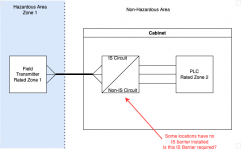marksluser
Member
- Location
- Calgary, Alberta, Canada
- Occupation
- Automation and Software Engineer
I am tasked with designing electrical controls/automation/instrumentation cabinets and field wiring to instruments in hazardous locations like class I Zone 0, 1, and 2 (div 1 and div 2).
In general, wiring and devices need to be rated for the environment (hazardous location) they are in.
However, when your circuit crosses zones, ex. zone 0 to zone 1 or zone 1 to zone 2 then you need to ensure the wring and components will not cause an ignition in the more dangerous zone.
For the devices, they need to ensure they have a rating equal to or higher than the zone they are placed in. Ex. instrument rated for zone 1 can be placed in zone 1 or zone 2.
For cables and conduit, they need to be sealed at one end to ensure dangerous gases do not migrate into general purpose or less hazardous locations.
For the design of the circuit, one of the most effective ways to mitigate the hazard is to use intrinsic safety.
Intrinsic safety ensures the energy in the circuit is low enough to prevent ignition if the wires were to cause short in the hazardous area. For some gases, a short that results in a spark may not cause ignition and is still considered safe. The biggest advantage of intrinsic safety is it allows live maintenance of devices when connecting or disconnecting wires.
A common design pattern for intrinsically safe circuits is to use zener barriers with current limiters to ensure the voltage and current are limited, thereby limiting the energy that can pass through them.
Often in the field I see designs without the hazardous area barriers because the instruments are connected to device like PLCs rated for zone 2.
The Canadian Electrical Code section 18 - Hazardous Locations discusses the requirements for wiring, instruments and other devices.
It says that intrinsic safety is a permitted method to design circuits in hazardous areas.
For a circuit to meet Canadian electrical code, does the attached circuit need an intrinsically safe barrier ?
Thank you.
In general, wiring and devices need to be rated for the environment (hazardous location) they are in.
However, when your circuit crosses zones, ex. zone 0 to zone 1 or zone 1 to zone 2 then you need to ensure the wring and components will not cause an ignition in the more dangerous zone.
For the devices, they need to ensure they have a rating equal to or higher than the zone they are placed in. Ex. instrument rated for zone 1 can be placed in zone 1 or zone 2.
For cables and conduit, they need to be sealed at one end to ensure dangerous gases do not migrate into general purpose or less hazardous locations.
For the design of the circuit, one of the most effective ways to mitigate the hazard is to use intrinsic safety.
Intrinsic safety ensures the energy in the circuit is low enough to prevent ignition if the wires were to cause short in the hazardous area. For some gases, a short that results in a spark may not cause ignition and is still considered safe. The biggest advantage of intrinsic safety is it allows live maintenance of devices when connecting or disconnecting wires.
A common design pattern for intrinsically safe circuits is to use zener barriers with current limiters to ensure the voltage and current are limited, thereby limiting the energy that can pass through them.
Often in the field I see designs without the hazardous area barriers because the instruments are connected to device like PLCs rated for zone 2.
The Canadian Electrical Code section 18 - Hazardous Locations discusses the requirements for wiring, instruments and other devices.
It says that intrinsic safety is a permitted method to design circuits in hazardous areas.
For a circuit to meet Canadian electrical code, does the attached circuit need an intrinsically safe barrier ?
Thank you.

